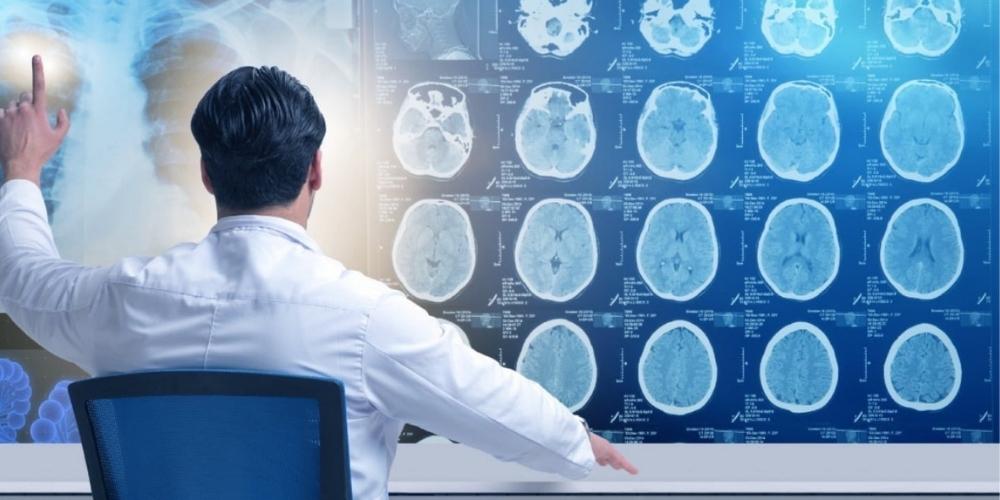Artificial intelligence (AI) is a wonderful tool making its way into various industries, and medical imaging is no exception.
Hospitals around the world perform 3.6 billion imaging procedures, producing 50 petabytes of data annually. Even with these already high numbers,, this demand is rapidly rising! Collecting, reading, and processing such data are tasks completed by radiologists, and with such a high volume, it's easy for them to have a hard time getting their work done efficiently.
The sharp increase of the demand is explained by two main factors. First, ultrasound guidance for procedures gained popularity in many clinical areas in the last ten years, beyond sonography. The reasons behind this success are an increase in confidence performing procedures, a reduction of complications, and an increased speed of the interventions. The second reason for this demand is linked to the current pandemic: ultrasound can help diagnosis coronavirus, evaluate its severity, and track progress. The mobility of point-of-care ultrasound (POCUS) eliminates the need to transport patients to the imaging suite, thereby making it an ideal choice for diagnosing and examining suspected or confirmed COVID-19 patients.
A recent survey led by GE Healthcare of UK and U.S. radiology department heads and administrators highlighted that more and more radiologists are on the verge of burnout. Many radiologists find themselves working in departments that are in dire need of fresh recruits, since their turnover rate is higher than in most other departments.
Something must be done to help radiology staff better manage this increasing demand, and while waiting for new radiologists to be trained, AI could be the answer.
Artificial Intelligence is a wonderful tool that has many applications in the healthcare sector. To be efficient, an AI program must be properly trained, and the more data it can use, the better it will behave. This makes the large amount of data produced by medical imaging a perfect fit for AI. Moreover, a lot of the tasks related to medical imaging are repetitive, meaning automation could bring more efficiency.
How do AI solutions help radiologists?
AI has made its way to radiology through picture archiving and communication system (PACS) platforms. These diagnostic imaging and workflow solutions allow radiologists to have access to many aspects of their work on a single platform: diagnostic reading, exam workflow, AI, 3D postprocessing, enterprise visualization, and archiving. Integrating AI algorithms for clinical uses with PACS workflow can help radiologists focus only on what they should be doing: accurately reading the right exam at the right time. A recent study from GE Healthcare demonstrated that using those last generation PACS can lead to 50% or higher increase in radiology efficiency for certain types of exams.
AI-based decision support software
AI in radiology is a tool, not a sentient being. As such, it will never be able to act as a replacement for human beings. However, it can be used to truly augment human activity, as pointed out in a report published by Accenture. A vivid example is the case of Global Diagnostics Australia, one of the first diagnostic imaging companies in Australia to use AI as part of its radiology workflow, achieving encouraging results for both onsite radiology and teleradiology. The AI solution they use analyzes medical imaging to flag acute abnormalities. Doing so helps radiologists prioritize life threatening cases and expedite patient care.
Faster RTAT thanks to AI
Using AI allows for data to be embedded within the workflows, and therefore it can be easily extracted to facilitate reports, accelerating report turnaround time (RTAT). This means that physicians can focus on diagnosing while saving time on tedious tasks. It helps improve their working conditions and increases the number of patients they can examine daily.
Improved accuracy and quantification
Even an experienced radiologist can miss anomalies. Using AI can add a layer of precision in the search for anomalies that sometimes go unnoticed. Moreover, overnight shifts and an overwhelming amount of work can have an effect on a physician's performance, but it has no effect on AI, thereby making it the ideal "assistant."
Additionally, measuring lesions is a tedious and repetitive task that can become incredibly time- consuming. AI can ease this burden via automation, which enables radiologists to focus on more important work.
What does the future hold for AI in radiology?
More and more AI vendors are offering programs designed for the detection of different pathologies and this trend is expected to accelerate in the coming years. To make sure that those different programs do not conflict but rather complement each other when possible, they must be integrated to an AI operating system (OS). Companies like Aidoc are already offering such solutions, orchestrating the algorithms of the integrated solutions by selecting the most relevant ones to match the suspected pathology, generating alerts, and facilitating care coordination.
Additionally, most experts expect AI adoption to increase in radiology in the following years. six years ago, no radiologists reported using AI in any way. In 2020, 30% indicated that they use AI.
Mass General Brigham Health System’s Chief Data Science Officer, Dr. Keith Dreyer, recently shared his vision of the future of AI in radiology. He envisions that over the next 10-15 years, the average radiologist will be practicing with 20-40 algorithms, depending on their subspecialties, thanks to more models becoming available and adopted. They will be better able to detect and identify rapidly declining disease states, quantify lesions, and predict morbidity and mortality from images.
Technically, the future is already here when considering AI in radiology. Algorithms will be improved, they could also be combined to offer redundancy on their flags and diagnosis. Using them as a second layer of precision for diagnosis, or as a way to improve triage and monitoring, is already bringing incredible added value to radiologists. AI alleviates the burden of certain tedious tasks, facilitating increased efficiency and precision: we like to think of it as the team member that never sleeps, always using maximum efficiency, helping the whole team and improving patient care.







